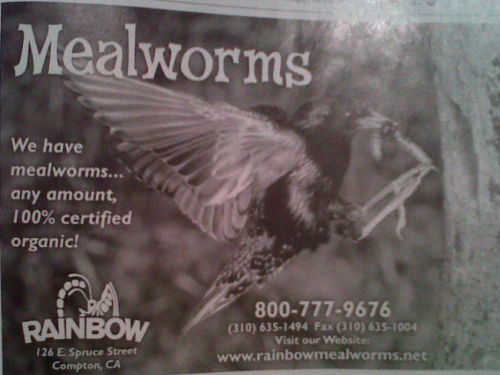Rainbow Mealworms Is In Dire Need Of A Bird Consultant
Oh, Rainbow Mealworms, why couldn't you have had a birder to take a quick look at this ad before you submitted it for print? I feel for you, I bet you'll get a few phone calls over this one.

I was thumbing through one of the many bird magazines that find their way into my mailbox when this half page ad caught my attention. Rainbow Mealworms used a starling as the target bird to attract with their product for a US bird publication. This is a bit of an advertising blunder when you consider the type of birders who purchases mealworms: bluebird and purple martin enthusiasts.
Mealworms gained a place on wild bird specialty store shelves because bluebirds do not eat seeds and bluebird trail monitors wanted a way to offer them food. Starlings are one of the birds bluebird and purple martin enthusiasts work to great lengths to avoid since this introduced species will displace so many birds from nesting cavities like bluebirds, purple martins and flickers. Using a starling in the advertising is somewhat of a smack in the face akin to giving the peace sign backwards in the United Kingdom. Mealworms are a great addition to any feeding station, regulars like cardinals, chickadees and nuthatches eat them but so do catbirds, orioles and robins. I've yet to see any US bird feeding enthusiast anxious to attract starlings.
I don't blame the magazine's editorial staff for this one. Editors have remarkably little control over the ads, especially in this media era when few advertisers are investing in print. Often, the advertisers are submitting their pre designed ads last minute and the ads are put in with very little thought. A company should do a bit of research before they do their marketing. I'm sure both the magazine and the company will get some emails over this. Perhaps some enterprising bluebird or purple martin enthusiast will offer use of their photos of birds eating mealworms in exchange for a few bags of a 1000 Mealworms?
Rainbow Mealworms has had a tough few years. They are the biggest supplier of mealworms to North America and were one of the reasons for the mealworm shortage in 2008.
Better luck next time, Rainbow Mealworms.
